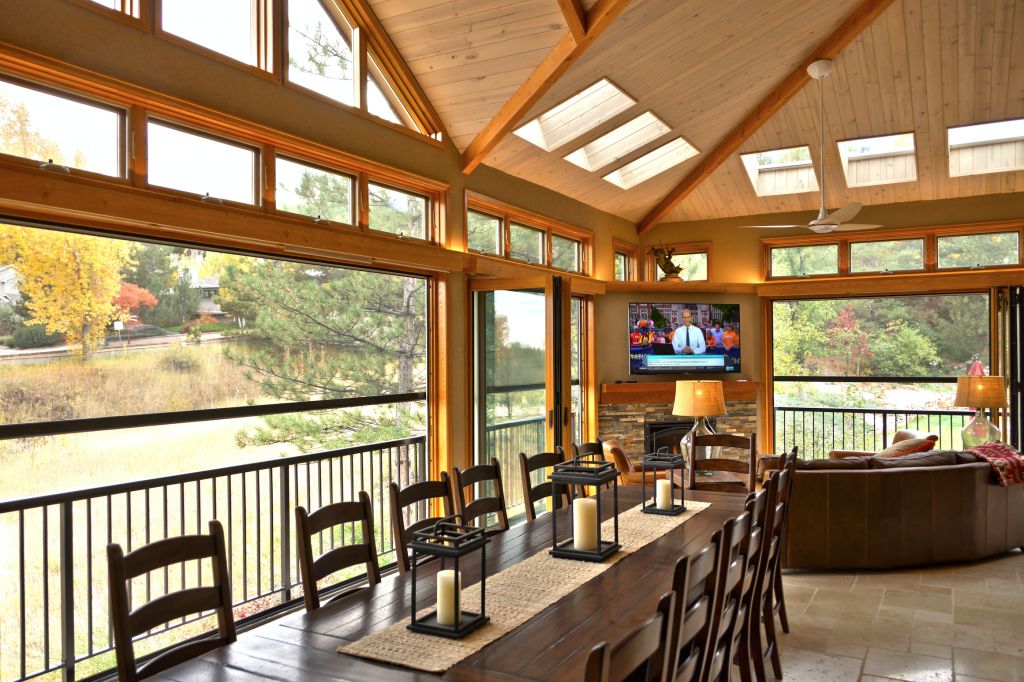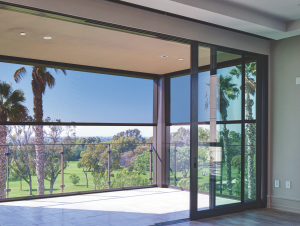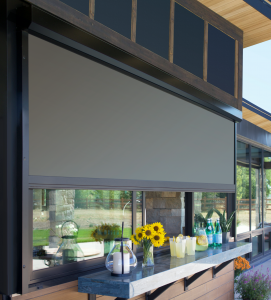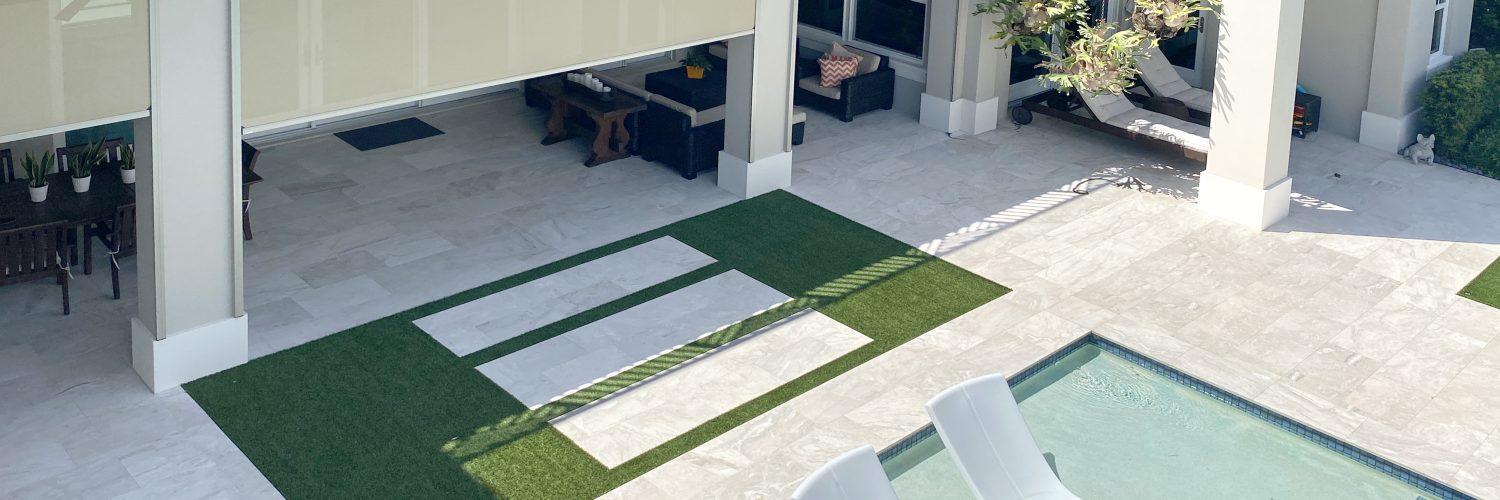One of the fastest-growing trends I am seeing in the new home construction and renovation industry is the creation of very large patio openings, mainly multi-panel sliding or folding glass doors.
Not that long ago, having a 12-foot-wide sliding glass door was considered an extra-large opening. Now, on a regular basis, I am seeing openings that are 20 to 30 feet wide, and it can be very challenging to effectively cover this size opening. Now, I admit, these larger openings are more prevalent on the West Coast, but I continue to get more calls from farther east in the U.S. every year.
I am going to conveniently skip over the debate as to all the different window coverings that may be used to cover large openings and focus specifically on roller shades. With the popularity of roller shades and the wide array of fabric options available, I find them to be the easiest way to cover these large openings. The real trick is customizing the shades both to serve the opening and the demands of the client. I also must point out that I only offer solutions to my clients with roller shades that will be motorized.

The first thing to consider with very large roman shades is the construction of the doors. Are they folding? Sliding? How many door panels are there for the opening? Do they have frames around the glass panes? Or are they frameless panes? If they are fold, do they fold in or out of the room? Does one door open independently? (Most manufacturers offer a single door at one end that will open independently without having to fold the other doors.) Are there any obstructions when the doors are opened or closed, including door handles or hinges? If they are sliding doors, what is the recess depth from the first door to the last? Also, do they slide from left to right, right to left, both ways, or center opening?
And just like panel track shades, the first panel and the last panel are on separate tracks, thus one is farther from the wall surface than the other. Except with doors, they are much thicker, so the more sliding doors you have, the farther your fabric will be from the deepest recessed door. All of the above questions will help you customize the shade’s options.
The next thing to consider with very large roman shades is the selection of the fabric: screen, privacy, room darkening or a dual shade system. This is a very straightforward question, but the next question is more important. How many panels of fabric is the client OK with using to cover the doors? Are they expecting one piece of fabric to cover the entire opening? Or one panel of fabric for each door panel? Or a combination of fabric panels and door panels? The answer to this question is what presents the challenge. And the wider the opening and/or the higher number of doors, the more challenging the project becomes.
So, let’s start with one panel of fabric to be used to cover the entire opening. Depending on the overall width and height of the door, this may seem impossible, but there are manufacturers that can make a single shade up to 40 feet wide. (This is correct: A 40-foot-wide covering can be made with a single piece of fabric.) And many manufacturers are starting to make even wider options. There are also multiple manufacturers that have 24-foot-wide shades made with a single piece of fabric as a standard offering in their collections. For some, it is offered as an exterior option, but the shade can easily be used indoors. The single-piece-of-fabric shade is a great option if the client can afford it.

However, there are some drawbacks and concerns that need to be addressed to this shade option in addition to the price. Size and weight are also important things to consider. Generally, the wider the shade, the larger the tube must be. Some larger shades may require a 9-inch mounting surface and can weigh hundreds of pounds. So, mounting them securely may be a challenge.
Another challenge such a large shade presents is its shipping, transportation, and installation. It will definitely take several installers, and you must also consider how you are going to deliver the very large shade to the job site and possibly how are you going to get it into the home or building. If you do not have easy access to the exterior of the opening, installation may become very difficult. This size of shade does not fit down hallways, onto elevators or through stairwells.
Another major concern with such a large single piece of fabric is curling. These very large shades must have the fabric railroaded because the wider the shade, the more the fabric is likely to distort. You need to explain to your clients that curling is going to happen. There will definitely be ripples, waviness, smiling, curling, or some form of fabric distortion on shades of this size.
But, there are things that can be done to reduce the distortion of the fabric, including the selection of the manufacturer’s preferred fabric for this size of the opening. It is also recommended that a heavy hembar is used, as well as using cable guides or tracks to include the zipper tracks. Yes, I have used tracks and cables for interior projects. They can be hidden with drapery panels or, if the shade goes from wall to wall, the track may be painted to easily blend with the walls.
But, what do you do when a single piece of fabric shade is not right for the job? You can do individually motorized shades for each fabric panel and the fabric panels can cover a single door panel or multiple door panels depending on what the client decides. An increased number of panels means more motors and makes the project more expensive.

However, the multiple door panels may become an issue when you have an uneven number of doors. For example, if you have six sliding door panels, it is easy to make six individual panels (one fabric panel for each door) or three fabric panels (each to cover two doors) or two fabric panels (each to cover three doors). In each of these cases, the fabric panels will have the same width and be able to create a very uniform look. But with an odd number of door panels, if you do not do individual fabric panels for each door, you will have to decide where the smaller panel of fabric goes. I recommend the smallest panel go on the door panel that gets the most use (i.e., this is usually the first sliding or folding door) because it is most likely the panel that will be raised and lower more than the other panels, which could feature the more uniformed look.
So, if you have a five-panel door, I recommend doing two fabric panels that each cover two doors and then a single panel for the remaining door. However, there is another option that I frequently use when I am not doing a single piece of fabric shade: the designing of coupled or banded shades. This allows the client to have the most choice for combining fabric panels with the least number of motors required.
This means a coupled shade with one fabric per tube and having the multiple tubes joined by a coupler allows a single motor to turn multiple tubes. A banded shade is multiple bands of fabric on a single tube with a small gap between each piece of fabric. It looks like a coupled shade, but it is a single tube, thus, fewer brackets to install and you can control the gap widths. Either option allows you to customize the project to the number of fabric panels that your client wants while also limiting the number of motors required. You can even couple multi-banded shades for even more options. And with these options, you can provide your client with their preferred panel configuration and include as many motors as necessary to achieve the desired look and function.
As the demand for more extremely large openings continues to increase, more and more manufacturers will begin to offer many more options to meet the increased demand. But, it is very important to make sure you understand what each manufacturer offers and what the limitations are with each of their products.
You also want to make sure you stay up to date with what is available on the market because if you can’t deliver what your client is looking for, they will go elsewhere. And, of course, if you can offer what your competitor can’t, just like the trend for shades for larger openings, your services will be in greater demand.
About the Author:
O’D McKewan is the product coach for Window Covering World and an expert on motorization and an industry leader in the field of motorized window coverings. He has extensive hands-on experience with motorized window coverings, including fabrication, installation, and selling.



